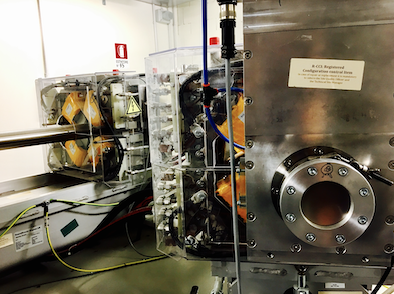Speaker
Description
The possibility to use polymer based scintillators for the detection of ionizing particles is of extreme interest in several fields, ranging from security purposes, where the revelation of neutrons and gammas is mandatory to hamper the traffic of nuclear weapons, workers radioprotection in sites as nuclear energy plants nuclear medicine laboratories and nuclear physics research facilities, design and built-up of original calorimeters to track muon. Polymeric materials present enormous advantages over inorganic scintillator: they are economic, they can be produced in several shapes and thickness, they are lightweight and display fast response time (ns). The light output is lower, but not dramatically, than most of inorganic crystals, but plastics are resistant to humidity and impacts, whereas handling the precious, fragile crystals to couple it with the optics/electronics acquisition set-up might represent a challenging task.
In the last decades our research group developed new scintillators based on polysiloxane with added fluorophores to obtain flexible, transparent, tough, radiation responsive sensors with optimal performances as for light output, different particles sensitivity and recognition, and response repeatability. This flexible, lightweight and biocompatible material shows significant evidences of its possible and profitable use in the field of biomedical devices as in vivo radiation detector. In particular, the detection of protons during hadron therapy for specific cancer treatment is of paramount importance in order to precisely deliver the beam to the designated site with the maximum precision, thus preserving the surrounding normal tissue from damage. In this presentation, we show the response of selected series of siloxane scintillators to a H+ beam with energy of 37 MeV, available at the proton-therapy centre of the Provincia Autonoma di Trento (APSS). The samples, obtained as pellets with 1” diameter and two different thickness (1 mm and 20 mm), have been investigated in terms of ion beam induced luminescence (IBIL) and responsivity, evaluated with a power meter. In the case of IBIL technique, the scintillation light spectrum from 20 mm thick samples is recorded in real time during irradiation with a light collecting fiber and a “movie” of possible damaging events occurring to the polymer matrix and the dissolved dyes is recorded, observing the fate of their respective excited states. This experiment evidenced a stable emission signal, peaked at 430 nm, whose features remain unchanged up to high final fluence. In a contemporary experiment, using the back side of the same thick sample, the power of emitted light as A/W is measured directly, exploiting the full stopping of the beam into the 20 mm pellet (estimated range is 14 mm for 37 MeV). Once fixed the beam current, which has been selected in the range 1 – 300 nA, and in turn the proton flux, we varied the irradiation time between 1 s and 10 s and continuously measured the current in output of the power meter (Newport, sensor 818- SL). In this way, it is possible to estimate: i) the detection limit of the scintillator, ii) the linearity of the response versus proton flux, iii) the stability of the response for increasing ion fluence. The same experiment has been done using 1 mm thin scintillators coupled to an acrylic light guide to drive the signal to the power meter, with the aim of simulating the prototype of sensor proposed in the FIRE project: a fully flexible radiation monitor to preserve healthy tissues during prostate cancer treatment by hadron therapy.

